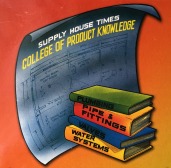
Typical external flow control as per ASME A112.14.3 type A, or PDI-G101. All graphics courtesy of Schier Products.
Several articles have been written over the years on the nomenclature and technical aspects of fats, oils and grease (FOG) abatement products1. But few have been written on the state of the industry in which these products are used. In shedding light on the current state of affairs, this article hopes to kick-start the process to reorganize our efforts as an industry to more effectively and efficiently protect our sewers from FOG.
As with any industry, the “FOG marketplace” is made up of a diverse group of stakeholders, each with its own agenda. The interaction of these agendas shapes the marketplace and ultimately dictates what products are available to the end user. The questions we hope to raise are: Is the current FOG marketplace conducive to healthy competition? Does it allow for the timely review of new and emerging technologies? Does it allow for the best products and solutions to be made available to the end user?
The common-sense notion to keep grease out of our sewer lines is not a new one. The first grease interceptors were put into use more than 120 years ago, employing a design patented by California native Nathaniel Whiting in 18842. In 1949, the Plumbing and Drainage Institute made the first attempt to standardize Whiting-based grease interceptor designs, ultimately leading to the creation of the PDI-G101 standard. The American Society of Mechanical Engineers then published the A112.14.3 series of standards in 2000, expanding upon PDI-G101 by including two additional sizes and allowing for multiple flow control methods.
The primary federal law governing water pollution, 1977’s Clean Water Act, gave the Environmental Protection Agency the platform it needed to enforce water quality benchmarks. Since then, the EPA has increased pressure (mostly in the form of fines), causing the national dialogue on “FOG abatement.”
During this national discourse, every aspect of FOG abatement has been discussed and dissected in detail, but surprisingly little consensus has been reached. As a result, there is as yet no national blueprint for fighting FOG, and as an industry we seem more confused on the topic than ever.

Example of grease interceptor with built-in flow control per ASME A112.14.3 type C.
The Stakeholders
To understand the cause of our current state of confusion, we must understand the perspectives of all stakeholders, and their effect on the FOG abatement industry at large. The following paragraphs highlight the main industry stakeholders, and their primary focus pertaining to FOG abatement:Plumbing Engineers:Engineers are tasked to design a plumbing system that will be safe and long lasting for the owners and occupants of the building. This includes any grease abatement fixtures and piping. They must also work within the applicable plumbing codes, understand and abide by the requirements of the local jurisdiction, and serve their ultimate customer, the building owner.
Plumbing Contractors:The installing contractor can only install what is acceptable to the local jurisdiction (which is not necessarily what the adopted model code suggests). Other concerns include what will fit (physically) at the installation location, quality of product, availability of product and price.
Building Owner/Operators:While grease abatement is a large factor in a commercial kitchen, it is not part of the core business, and is usually viewed as a necessary evil or cost of doing business. Depending on the owner’s modus operandi, and the type of building that is being planned, the owner may want the lowest-cost solution, or a quality, long-lasting solution. All building owners want a FOG abatement solution that is quick and easy to maintain.
Local FOG/Pre-Treatment Authorities:Pre-Treatment groups are primarily concerned with the quality of wastewater discharged to the local wastewater treatment plant. They are also tasked with keeping the public collection system running efficiently. Any FOG ordinance enacted above and beyond the plumbing code must be fair, understandable and enforceable. This group usually sets the maintenance schedule for the FOG abatement device.
Plumbing Inspectors:The plumbing inspection office must make sure all FOG abatement products are code acceptable and installed per the code. The plumbing inspector may or may not have jurisdiction over the sizing of the unit. In most jurisdictions, once the unit is installed and has passed inspection, the plumbing inspector’s job is done.
Maintainers/Pumpers:FOG abatement systems require regular cleaning and/or maintenance. The maintainer could be an employee of the building, but is usually a professional pumping service. Pumper contractors must remove the entire liquid and solid contents from a grease interceptor to restore it to its peak efficiency.
Pumpability of large grease interceptors is also a concern - interceptors of 1,500 gallons and above use much of the holding capacity of the pumper truck, meaning the contractor gets fewer pumpings per trip. Interceptors larger than 3,000 gallons may require two trucks to be adequately pumped and cleaned. Jurisdictions are increasingly requiring pumper contractors to report the physical state of the interceptor as they are the only ones that can view the inside of the units when empty.
Manufacturers:The manufacturer designs and builds a device that will be acceptable to the industry. Some manufacturers rely on older technology while others continue to innovate.
Standards Organizations:Best practices must be identified and distributed through the standards process. Standards organizations provide this service and are very important. Their goal is to help keep the industry safe and efficient by providing quality, design, and installation benchmarks.
Model Code Organizations:Much like standards organizations, the model codes’ goal is to help keep the industry safe and efficient by providing quality, design, and installation benchmarks.
With these varying interests turned loose in the market, the following results have occurred:
Also, manufacturers are advertising and lobbying to keep old technology viable, and disseminating accurate information as well as misinformation. Other manufacturers are marketing and lobbying for new and innovative products not covered by current codes and standards that have been slow to react to the changing marketplace.
Different names have emerged for products with similar design and function (grease trap, grease interceptor, gravity grease interceptor, hydro-mechanical grease interceptor). Sizing guidelines that change wildly based solely on if the unit is inside or outside of the building.
Further, engineers and contractors cannot identify, let alone employ, consistent FOG abatement designs and practices because the requirements are too different from jurisdiction to jurisdiction. The desire to design and install better systems and products eventually succumbs to the fatigue of dealing with differing local FOG restrictions. This same fatigue might also be one reason for the general lack of innovation from manufacturers over the last 120 years.
Contractors are forced to install products that have proven to fail, but are code acceptable. Products installed in a code-acceptable manner can be such a headache to the restaurant that they are often altered immediately after inspection.
Restaurant owners/operators have few options and are typically made to use products that are expensive to install, maintain, and ultimately, replace. Innovative products have extreme difficulty entering the marketplace. Some local codes require interceptors so large that they cannot be adequately pumped and cleaned, and can only affordably be built from concrete, a material unsuitable for FOG contact unless treated3.

Large-capacity polyethylene grease interceptors being installed.
Call For Consensus
When we stand back and look broadly at the FOG abatement industry, It’s easy to see why the designs and standards have changed little since Whiting’s design more than 120 years ago. It is also apparent why we are as far from a national consensus FOG abatement strategy as ever.In writing this editorial, we are hoping to instigate a national dialogue to either improve upon an existing consensus standard or to create a new consensus standard. The scope of the standard would cover all installations: above or below grade, indoor or outdoor, and would also cover grease-removal devices.
This standard should be performance-based while outlining basic structural and material requirements that ensure ease of maintenance, user safety, and product longevity. With performance as the basis of the standard, new and emerging technologies will be given equal opportunity, and a healthy, competitive marketplace would do its part to bring the best products to the end user.
References
1. FOG (fats, oils, grease) Abatement Products will be used as a generic term to refer to: volume-based grease interceptors, flow-based grease interceptors, grease-removal devices and bacteriological grease removal systems.2. Plumbing & Drainage Institute - Standard PDI G-101, p. 2.
3. Portland Cement Association - “Effects of Substances on Concrete and Guide to Protective Treatments” (2001).
Note: The views expressed here are strictly those of the authors and do not necessarily represent PM Engineer or BNP Media.

